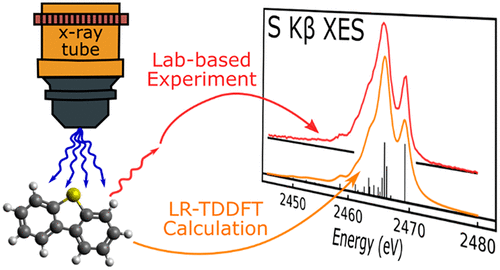当前位置:
X-MOL 学术
›
J. Phys. Chem. A
›
论文详情
Our official English website, www.x-mol.net, welcomes your
feedback! (Note: you will need to create a separate account there.)
Probing Sulfur Chemical and Electronic Structure with Experimental Observation and Quantitative Theoretical Prediction of Kα and Valence-to-Core Kβ X-ray Emission Spectroscopy.
The Journal of Physical Chemistry A ( IF 2.7 ) Pub Date : 2020-06-02 , DOI: 10.1021/acs.jpca.0c04195 William M Holden 1 , Evan P Jahrman 1 , Niranjan Govind 2 , Gerald T Seidler 1
The Journal of Physical Chemistry A ( IF 2.7 ) Pub Date : 2020-06-02 , DOI: 10.1021/acs.jpca.0c04195 William M Holden 1 , Evan P Jahrman 1 , Niranjan Govind 2 , Gerald T Seidler 1
Affiliation

|
An extensive experimental and theoretical study of the Kα and Kβ high-resolution X-ray emission spectroscopy (XES) of sulfur-bearing systems is presented. This study encompasses a wide range of organic and inorganic compounds, including numerous experimental spectra from both prior published work and new measurements. Employing a linear-response time-dependent density functional theory (LR-TDDFT) approach, strong quantitative agreement is found in the calculation of energy shifts of the core-to-core Kα as well as the full range of spectral features in the valence-to-core Kβ spectrum. The ability to accurately calculate the sulfur Kα energy shift supports the use of sulfur Kα XES as a bulk-sensitive tool for assessing sulfur speciation. The fine structure of the sulfur Kβ spectrum, in conjunction with the theoretical results, is shown to be sensitive to the local electronic structure including effects of symmetry, ligand type and number, and, in the case of organosulfur compounds, to the nature of the bonded organic moiety. This agreement between theory and experiment, augmented by the potential for high-access XES measurements with the latest generation of laboratory-based spectrometers, demonstrates the possibility of broad analytical use of XES for sulfur and nearby third-row elements. The effective solution of the forward problem, i.e., successful prediction of detailed spectra from known molecular structure, also suggests future use of supervised machine learning approaches to experimental inference, as has seen recent interest for interpretation of X-ray absorption near-edge structure (XANES).
中文翻译:

用实验观察和定量理论预测Kα和化合价KβX射线发射光谱探测硫的化学和电子结构。
提出了含硫系统Kα和Kβ高分辨率X射线发射光谱(XES)的广泛实验和理论研究。这项研究涵盖了广泛的有机和无机化合物,包括来自先前发表的工作和新测量的大量实验光谱。利用线性响应时变密度泛函理论(LR-TDDFT)方法,在计算核对核Kα的能量位移以及化合价中的整个光谱特征时发现了很强的定量一致性。核心Kβ光谱。精确计算硫Kα能量位移的能力支持使用硫KαXES作为评估硫形态的体积敏感工具。结合理论结果,得出硫Kβ光谱的精细结构,所示的化合物对局部电子结构敏感,包括对称性,配体类型和数目的影响,并且对于有机硫化合物,对键合的有机部分的性质敏感。理论和实验之间的这种共识,加上使用最新一代基于实验室的光谱仪进行高通量XES测量的潜力,证明了XES可广泛用于硫和附近的第三行元素的分析用途。正向问题的有效解决方案,即从已知分子结构成功预测详细光谱,还建议在未来使用监督式机器学习方法进行实验推断,如最近对解释X射线吸收近边缘结构的兴趣( XANES)。配体的类型和数量,如果是有机硫化合物,则取决于键合的有机部分的性质。理论和实验之间的这种共识,加上使用最新一代基于实验室的光谱仪进行高通量XES测量的潜力,证明了XES可广泛用于硫和附近的第三行元素的分析用途。正向问题的有效解决方案,即从已知分子结构成功预测详细光谱,还建议在未来使用监督式机器学习方法进行实验推断,如最近对解释X射线吸收近边缘结构的兴趣( XANES)。配体的类型和数量,如果是有机硫化合物,则取决于键合的有机部分的性质。理论和实验之间的这种协议,加上最新一代基于实验室的光谱仪进行高通量XES测量的潜力,进一步证明了XES可广泛用于硫和附近的第三行元素的分析可能性。正向问题的有效解决方案,即从已知分子结构成功预测详细光谱,也暗示了有监督的机器学习方法可用于实验推断,正如最近看到的对解释X射线吸收近边缘结构的兴趣( XANES)。最新一代基于实验室的光谱仪为XES测量提供了更高的潜力,这表明XES可广泛用于硫和附近的第三行元素的分析用途。正向问题的有效解决方案,即从已知分子结构成功预测详细光谱,还建议在未来使用监督式机器学习方法进行实验推断,如最近对解释X射线吸收近边缘结构的兴趣( XANES)。最新一代基于实验室的光谱仪为XES测量提供了更高的潜力,这表明XES可广泛用于硫和附近第三行元素的分析用途。正向问题的有效解决方案,即从已知分子结构成功预测详细光谱,也暗示了有监督的机器学习方法可用于实验推断,正如最近看到的对解释X射线吸收近边缘结构的兴趣( XANES)。
更新日期:2020-07-02
中文翻译:

用实验观察和定量理论预测Kα和化合价KβX射线发射光谱探测硫的化学和电子结构。
提出了含硫系统Kα和Kβ高分辨率X射线发射光谱(XES)的广泛实验和理论研究。这项研究涵盖了广泛的有机和无机化合物,包括来自先前发表的工作和新测量的大量实验光谱。利用线性响应时变密度泛函理论(LR-TDDFT)方法,在计算核对核Kα的能量位移以及化合价中的整个光谱特征时发现了很强的定量一致性。核心Kβ光谱。精确计算硫Kα能量位移的能力支持使用硫KαXES作为评估硫形态的体积敏感工具。结合理论结果,得出硫Kβ光谱的精细结构,所示的化合物对局部电子结构敏感,包括对称性,配体类型和数目的影响,并且对于有机硫化合物,对键合的有机部分的性质敏感。理论和实验之间的这种共识,加上使用最新一代基于实验室的光谱仪进行高通量XES测量的潜力,证明了XES可广泛用于硫和附近的第三行元素的分析用途。正向问题的有效解决方案,即从已知分子结构成功预测详细光谱,还建议在未来使用监督式机器学习方法进行实验推断,如最近对解释X射线吸收近边缘结构的兴趣( XANES)。配体的类型和数量,如果是有机硫化合物,则取决于键合的有机部分的性质。理论和实验之间的这种共识,加上使用最新一代基于实验室的光谱仪进行高通量XES测量的潜力,证明了XES可广泛用于硫和附近的第三行元素的分析用途。正向问题的有效解决方案,即从已知分子结构成功预测详细光谱,还建议在未来使用监督式机器学习方法进行实验推断,如最近对解释X射线吸收近边缘结构的兴趣( XANES)。配体的类型和数量,如果是有机硫化合物,则取决于键合的有机部分的性质。理论和实验之间的这种协议,加上最新一代基于实验室的光谱仪进行高通量XES测量的潜力,进一步证明了XES可广泛用于硫和附近的第三行元素的分析可能性。正向问题的有效解决方案,即从已知分子结构成功预测详细光谱,也暗示了有监督的机器学习方法可用于实验推断,正如最近看到的对解释X射线吸收近边缘结构的兴趣( XANES)。最新一代基于实验室的光谱仪为XES测量提供了更高的潜力,这表明XES可广泛用于硫和附近的第三行元素的分析用途。正向问题的有效解决方案,即从已知分子结构成功预测详细光谱,还建议在未来使用监督式机器学习方法进行实验推断,如最近对解释X射线吸收近边缘结构的兴趣( XANES)。最新一代基于实验室的光谱仪为XES测量提供了更高的潜力,这表明XES可广泛用于硫和附近第三行元素的分析用途。正向问题的有效解决方案,即从已知分子结构成功预测详细光谱,也暗示了有监督的机器学习方法可用于实验推断,正如最近看到的对解释X射线吸收近边缘结构的兴趣( XANES)。











































 京公网安备 11010802027423号
京公网安备 11010802027423号